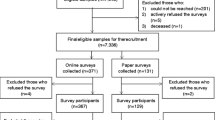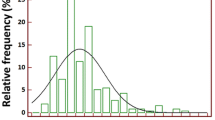Abstract
Objectives: Regular walking is associated with many health benefits and is of particular interest for the promotion of daily physical activity. The purpose of this study is to describe the epidemiology of walking for exercise among Canadian adults aged 18–55 years.
Methods: Nationally representative cross-sectional data from the National Population Health Survey and Canadian Community Health Survey from 1994/95 to 2007 were used for this study. The weighted and age-standardized prevalence of walking for exercise, walking duration, regular walking (at least 4 times a week) and deriving 100% of the total leisure-time physical activity energy expenditure (LTPAEE) from walking were calculated.
Results: Overall, 70% of Canadian adults walked for exercise at least once during the previous three months; however, only 30% of the population reported walking regularly, a figure that has remained relatively stable since 2001. Women, older adults, those with lower body mass index (BMI) and those with lower total household income reported regular walking more often than their counterparts. Women, older adults and lower-income Canadians also tended to derive 100% of their total LTPAEE from walking more often than men, young adults and those in higher-income groups.
Conclusion: Walking is a popular physical activity for Canadian adults, regardless of age, sex, BMI or income group, however, the prevalence of regular walking varies between demographic subgroups. Public health strategies that focus on promoting walking for exercise should consider these results when defining target audiences and designing interventions.
Résumé
Associée à de nombreux bienfaits pour la santé, la marche régulière présente un intérêt particulier pour la promotion de l’activité physique quotidienne. Cette étude vise à décrire l’épidémiologie de la marche de santé chez les adultes canadiens de 18 à 55 ans.
Méthode: Les données transversales de l’Enquête nationale sur la santé de la population et de l’Enquête sur la santé dans les collectivités canadiennes de 1994–1995 à 2007, qui représentent le pays entier, ont été utilisées pour cette étude. Nous avons calculé la prévalence, pondérée et standardisée selon l’âge, de la marche de santé, de la durée de la marche, de la marche régulière (au moins 4 fois par semaine) et de la dépense d’énergie totale pour l’activité physique durant les loisirs venant de la marche.
Résultats: Dans l’ensemble, 70 % des adultes canadiens avaient marché pour faire de l’exercice au moins une fois pendant les trois mois précédents; cependant, seulement 30 % de la population disait marcher régulièrement. Les femmes, les adultes âgés, les personnes ayant un faible indice de masse corporelle et les personnes ayant un faible revenu total du ménage ont dit marcher régulièrement plus souvent que les autres répondants. Les femmes, les adultes âgés et les Canadiens à faible revenu avaient aussi plus souvent tendance à dépenser l’énergie totale de l’activité physique en marchant comparativement aux hommes, aux jeunes adultes et aux personnes ayant un revenu élevé.
Conclusion: La marche est une activité physique populaire chez les adultes canadiens, peu importe l’âge, le sexe, l’indice de masse corporelle et le groupe de revenu; cependant la prévalence de la marche régulière varie d’un segment démographique à l’autre. Les stratégies de promotion de la marche devraient en tenir compte pour définir leur public cible et concevoir leurs interventions.
Similar content being viewed by others
References
Hakim AA, Petrovitch H, Burchfiel CM, Ross GW, Rodriguez BL, White LR, et al. Effects of walking on mortality among nonsmoking retired men. N Engl J Med 1998;338(2):94–99.
Hakim AA, Curb JD, Petrovitch H, Rodriguez BL, Yano K, Ross GW, et al. Effects of walking on coronary heart disease in elderly men: The Honolulu Heart Program. Circulation 1999;100(1):9–13.
LaCroix AZ, Leveille SG, Hecht JA, Grothaus LC, Wagner EH. Does walking decrease the risk of cardiovascular disease hospitalizations and death in older adults? J Am Geriatr Soc 1996;44(2):113–20.
Hu FB, Stampfer MJ, Colditz GA, Ascherio A, Rexrode KM, Willett WC, et al. Physical activity and risk of stroke in women. JAMA 2000;283(22):2961–67.
Hu FB, Sigal RJ, Rich-Edwards JW, Colditz GA, Solomon CG, Willett WC, et al. Walking compared with vigorous physical activity and risk of type 2 diabetes in women: A prospective study. JAMA 1999;282(15):1433–39.
Fogelholm M, Kukkonen-Harjula K, Nenonen A, Pasanen M. Effects of walking training on weight maintenance after a very-low-energy diet in pre-menopausal obese women: A randomized controlled trial. Arch Intern Med 2000;160(14):2177–84.
Dunn AL, Marcus BH, Kampert JB, Garcia ME, Kohl HW, III, Blair SN. Comparison of lifestyle and structured interventions to increase physical activity and cardiorespiratory fitness: A randomized trial. JAMA 1999;281(4):327–34.
Manson JE, Hu FB, Rich-Edwards JW, Colditz GA, Stampfer MJ, Willett WC, et al. A prospective study of walking as compared with vigorous exercise in the prevention of coronary heart disease in women. N Engl J Med 1999;341(9):650–58.
Hootman JM, Macera CA, Ainsworth BE, Martin M, Addy CL, Blair SN. Association among physical activity level, cardiorespiratory fitness, and risk of musculoskeletal injury. Am J Epidemiol 2001;154(3):251–58.
US Department of Health and Human Services. Physical Activity and Health: A Report of the Surgeon General. Washington, DC: US Department of Health and Human Services, 1996.
Health Canada, The Canadian Society for Exercise Physiology. Canada’s Physical Activity Guide to Healthy Active Living. Available online at: http://www.phac-aspc.gc.ca/pau-uap/fitness/pdf/guideEng.pdf (Accessed July 16, 2008).
Gilmour H. Physically active Canadians. Health Rep 2007;18(3):45–65.
Rafferty AP, Reeves MJ, McGee HB, Pivarnik JM. Physical activity patterns among walkers and compliance with public health recommendations. Med Sci Sports Exerc 2002;34(8):1255–61.
Siegel PZ, Brackbill RM, Heath GW. The epidemiology of walking for exercise: Implications for promoting activity among sedentary groups. Am J Public Health 1995;85(5):706–10.
Simpson ME, Serdula M, Galuska DA, Gillespie C, Donehoo R, Macera C, et al. Walking trends among U.S. adults: The Behavioral Risk Factor Surveillance System, 1987–2000. Am J Prev Med 2003;25(2):95–100.
Statistics Canada. Canadian Community Health Survey (CCHS) 2007 Micro-data files. User guide. Available online at: http://www.statcan.ca/english/sdds/document/3226_D7_T9_V4_E.pdf (Accessed November 10, 2008).
Taylor HL, Jacobs DR, Schucker B, Knudsen J, Leon AS, Debacker G. A questionnaire for the assessment of leisure time physical activities. J Chron Dis 1978;31:741–55.
Statistics Canada. Canadian Community Health Survey (CCHS) 2007 Derived Variable (DV) Specifications. Available online at: http://www.statcan.ca/eng-lish/sdds/document/3226_D2_T9_V4_E.pdf (Accessed November 10, 2008).
Research Triangle Institute. SUDAAN User’s Manual, Release 8.0. Research Triangle Park, NC: Research Triangle Institute, 2001.
Craig CL, Tudor-Locke C, Bauman A. Twelve-month effects of Canada on the Move: A population-wide campaign to promote pedometer use and walking. Health Educ Res 2007;22(3):406–13.
Reis JP, Macera CA, Ainsworth BE, Hipp DA. Prevalence of total daily walking among US adults, 2002-2003. J Phys Act Health 2008;5(3):337–46.
Craig CL, Russell SJ, Cameron C, Bauman A. Twenty-year trends in physical activity among Canadian adults. Can J Public Health 2004;95(1):59–63.
St-Pierre M, Béland Y. Mode effects in the Canadian Health Measures Survey: A comparison of CAPI and CATI. 2004 Proceedings of the American Statistical Association Meeting. Survey Research Methods. Toronto, ON: American Statistical Association, 2004.
Author information
Authors and Affiliations
Corresponding author
Rights and permissions
About this article
Cite this article
Bryan, S.N., Katzmarzyk, P.T. Patterns and Trends in Walking Behaviour among Canadian Adults. Can J Public Health 100, 294–298 (2009). https://doi.org/10.1007/BF03403950
Received:
Accepted:
Published:
Issue Date:
DOI: https://doi.org/10.1007/BF03403950
Keywords
- Walking
- leisure-time
- physical activity
- energy expenditure
- Canadian Community Health Survey
- National Population Health Survey




